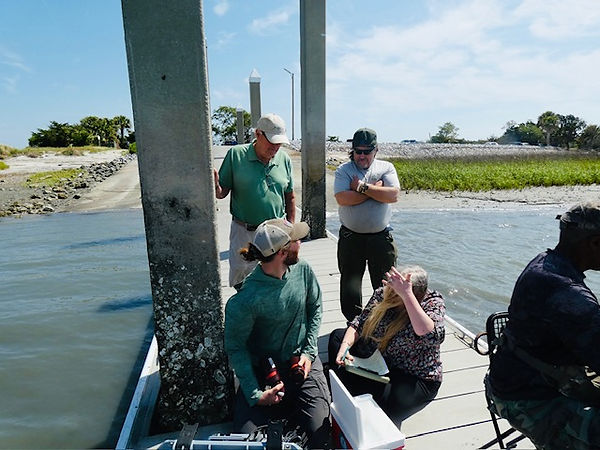The Environment at Hunting Island

Hunting Island is always changing. Migrating creatures in air and sea come and go with the seasons, and the natural forces of erosion constantly re-shape the island. Friends of Hunting Island State Park takes pride in our work to help foster this rich environment by helping with preservation, stewardship programs and membership funding for facility upgrades, additions, dune restoration initiatives, accessibility products such as mobi mats, beach wheelchairs and a host of volunteers to help champion the Hunting Island experience through its environment.
In addition to some 3,000 acres of salt marsh and more than four miles of beach, a large lagoon, created by sand dredging in 1968, has become a natural wonderland and home to such unexpected species as seahorses and barracuda.
Animal visitors include loggerhead turtles, which nest on the island in the summer months. On dry land and in and around freshwater ponds can be found deer and alligators, raccoons and even eastern diamondback rattlesnakes.
Hundreds of species of birds also are resident on or visit Hunting Island, including painted buntings, tanagers and orioles, along with pelicans, oystercatchers, skimmers and terns, herons, egrets and wood storks.
Hunting Island’s beaches are important for shorebirds and seabirds, which use the beach to feed, nest, and rest along their migration route. We ask all visitors to help protect these birds by giving them space, keeping out of posted areas, and keeping dogs on a leash at all times.
Please join us to help in our effort to keep this natural barrier island, and all its ecosystems, as protected as we can. For volunteer opportunities, which we host frequently, please select "environment" on the membership application. Our Director can be reached at FOHIenvironment@gmail.com should you have any questions.
A Community Collaboration for water quality testing by the
USCB Marine Biology Laboratory
The Port Royal Sound is a unique ecosystem on the Atlantic Coast. Unlike many of the estuaries in South Carolina, the Port Royal Sound (PRS) receives limited freshwater and sediment inputs from large rivers. In addition, the location of the Port Royal Sound creates large expanses of salt marsh.
In September 2017, a meeting was held among water quality stakeholders at the Port Royal Sound Maritime Center. The purpose of the meeting was to identify criteria that could be used to develop a prioritization model, which could help guide local land conservation efforts. Follow up meetings were held in February and April of 2018 to refine the model. Stakeholders have included representatives from Beaufort County, Beaufort Open Land Trust, Carolinas Integrated Sciences & Assessments, Coastal Conservation League, Lowcountry Land Trust, DNR, Spring Island Trust, NOAA, Port Royal Sound Foundation, The Nature Conservancy, University of South Carolina, and USFWS.
Using the results of that meeting, PRSF has been working on developing a process, program, and tools for monitoring key indicators of the health of the Port Royal Sound and watershed. To designate exactly what the watershed encompasses, PRSF is using the SC DNR-defined watershed boundary, which is then broken down into 37 smaller sub-watersheds defined by USGS as HUC12 (hydrologic units with a 12-digit code). A substantial portion of Hunting Island State Park is within the designated Port Royal Sound watershed.
PRSF decided to develop a Port Royal Sound Water Quality Monitoring Network to record water quality parameters because that information is foundational to everything else. Their aim is to develop baseline water quality trends and a web-based dashboard to organize and display this data. At the same time, PRSF has been working with USCB & SCDES to develop a “Level 2” water quality monitoring collection protocol that will ensure that the data collected is considered credible by the state. This water quality monitoring program will aim for more frequent monitoring using digital handheld YSI meters and samples that will be collected and analyzed at the USCB lab. The monitoring will be conducted by a network of partners, including USCB students, county staff, communities, concerned organizations such as the Friends of Hunting Island and citizen volunteers — a collaborative and holistic approach to monitoring and data sharing.
To assist the PRSF in this conservation effort, the Friends of Hunting Island has used funds to purchase a water quality meter that has been assigned to Hunting Island State Park full-time. The meter will be calibrated by PRSF on a routine schedule but will be under the care of the Friends of Hunting Island and Hunting Island State Park staff. The meter will also be used for other purposes — for example; one community is also using the meter for monitoring stormwater ponds.
The meter purchased was a YSI ProQuatro Multiparameter, manufactured by Xylem. It is a handheld electronic meter that supports the measurement of different parameters with add-on probes. It will be used to measure temperature, pH, dissolved oxygen, and salinity. The meters will also have calibration solution, a carrying case, and battery chargers.
FOHI is now looking to expand on our water testing to include other important watersheds on Hunting Island. In an effort to do so, we are seeking more volunteers to participate. Please contact our Director, Tim Moore at FOHIenvironment@gmail.com

Moody Boneyard–Joan Eckhardt

Marsh Birds–Gary Jones

Photo: Tim Moore



